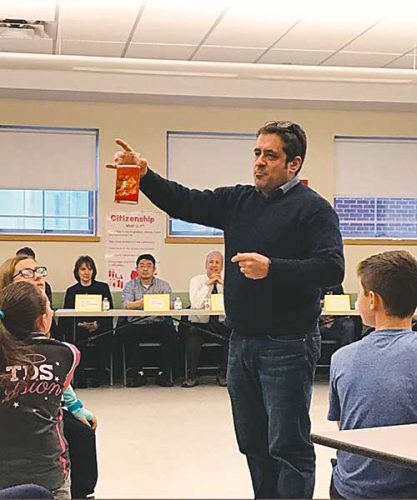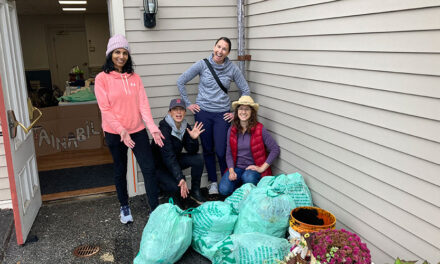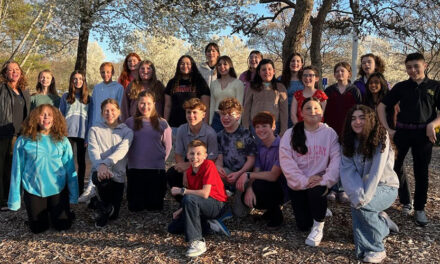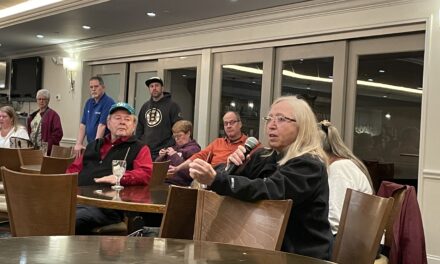Published in the February 8, 2018 edition
By MICHAEL GEOFFRION SCANNELL
NORTH READING — The Batchelder School held a Scientist Summit for its fifth graders, complete with a keynote speaker, on January 31.
It was a half day at the Batch, but the morning was filled with science demonstrations, some hands-on experimentation and in one case a crime scene investigation.
The Scientist Summit was the brainchild of Tina Borek, the science curriculum specialist for the Batchelder School and a grade 5 science teacher.

BIOMEDICAL SCIENTIST Garo Toby, the keynote speaker, addresses the opening session of the first Scientist Summit for fifth-graders at the Batchelder School on Jan. 31. He and his colleagues have created two drugs to date to benefit hemophiliacs. (Courtesy Photo)
Garo Toby, a biomedical scientist, was the keynote speaker. He works for a Cambridge-based company that has developed a hemophilia medication which has reduced the need for clotting agent injections from every day or every other day to once every two weeks. He explained to the students the different types of blood and the functions of white blood cells, red blood cells and plasma using visual aids and props.
Toby, like the other 13 participating scientists, had some connection to a fifth-grader. Most were parents.
Breakout sessions followed Toby’s keynote address. Organizers randomly split up the 86 fifth-graders into four classrooms, enabling three to four different scientists to share their talents with students in each of the classrooms. Most importantly, this would later allow for students to share their experiences and what they learned from each scientist’s presentation with classmates in their homerooms who may have attended different breakouts.
Here is some of what happened in these breakout sessions:
Jana Thomas explained to the students that she was not a state trooper but that she works with state troopers as a forensic scientist for the State Police. The first thing she did was ask for a volunteer. Thomas chose John O’Connell right from the front row. She proceeded to tell the fifth-grader that she was very busy today and asked if he could help her make dinner.
She gave him bread crumbs and some ground beef and asked him to make meatballs while she continued to talk to the class about DNA and hair and fiber trace evidence. After he was done making meatballs, he went and washed his hands. Then, using the ruse that there had been a fight out on the playground she tested his hands for blood with a chemical that changes color if blood was present. It turned bright blue. Thomas then swabbed his hands and explained that she could send that DNA evidence off to the lab to prove that it was not human blood. She then checked his hands for gunshot residue, just to be on the safe side.
Mary Hatton, an expert in science education and research, used magnets for a hands-on demonstration of this mysterious force. Hatton was very impressed with students’ ability to improvise experiments.
Jihua Ma, a solar engineer, had an extensive slide show about solar technology along with quizzes for the students complete with prizes.
Colleen Steinmeyer, a biochemist, asked students to design an origami cat. The students quickly realized that listening skills and following directions are both critical when medicines are created.
The other participating scientists were Lisa Ayer, a manufacturing engineer; Chris Davis, a mechanical engineer; Devon Dunajski, a geology student; Dan Kennedy, a software engineer; Mat Massicotte, a urologist; Elene McLaughlin, a clinical researcher; Joanna Mitrano, a dietitian; Andrew Stetson, a software engineer; and Kim Talbot, a dietitian.
“My wish was to empower fifth grade students to think outside the box, ask questions, and of course, spark an excitement for science!” Borek said.
“My first step was to mention my summit idea to a few parents in the science field at school events in the fall to test the waters and check for interest level. The feedback was positive.”
In early December Borek sent home a letter explaining her Scientist Summit idea with a sign-up form attached. By mid-December she had confirmed 14 scientists would volunteer.
In a thank you note to the scientists Borek wrote, “I believe the fifth graders will fondly remember the Scientist Summit for some time. Thanks to all of you, today was a top highlight of my 25-plus years of teaching.”
When asked by the Transcript if this will become an annual event, Borek replied, “Based on the positive feedback from the scientists, teachers and students, it is my hope that the event will continue to expand.”




